I was looking back on my food pictures on my phone, and I noticed one thing recently... I love stacked food. Simply stated, stacked food (or vertical food) is food you make in or serve in layers to magnify the beauty of your ingredients. I made a Tuna Poke stack in last month’s blog to showcase PRIDE colors. I don’t think you can look at a stack of food like this and not get an instant case of the smiles.
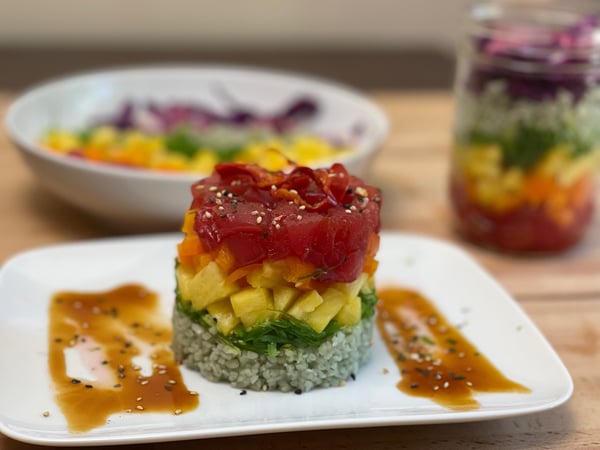 My love for stacked food started back in 1999 when my in-laws gave me Deborah Fabricant's book STACKS The Art of Vertical Food and the accompanying set of molds. It was a great way to not just to learn how to make layers but how to layer the flavors. The book had multiple stack matrixes, and I was instantly hooked.
My love for stacked food started back in 1999 when my in-laws gave me Deborah Fabricant's book STACKS The Art of Vertical Food and the accompanying set of molds. It was a great way to not just to learn how to make layers but how to layer the flavors. The book had multiple stack matrixes, and I was instantly hooked.
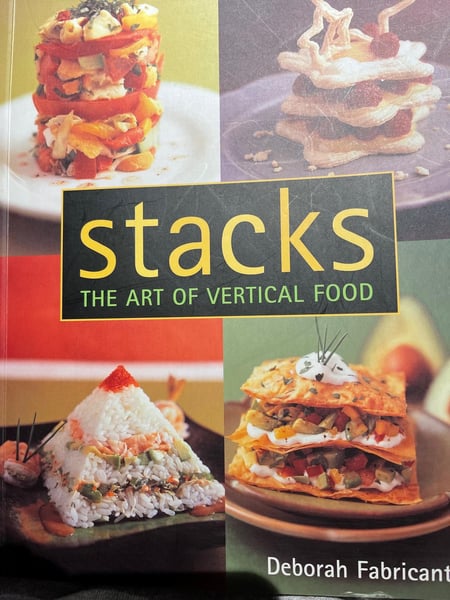 Stacks are a whimsical way to serve dinner guests or reinvent leftovers. The best part is that they can be either fancy or rustic. After a couple of decades of making stacks, I have come up with a couple of easy suggestions.
Stacks are a whimsical way to serve dinner guests or reinvent leftovers. The best part is that they can be either fancy or rustic. After a couple of decades of making stacks, I have come up with a couple of easy suggestions.
1. Molds: The mold kit I have is nice but you really don’t need it. You can make a mold out of a soup can (but use a can opener that takes away the sharp edges.)
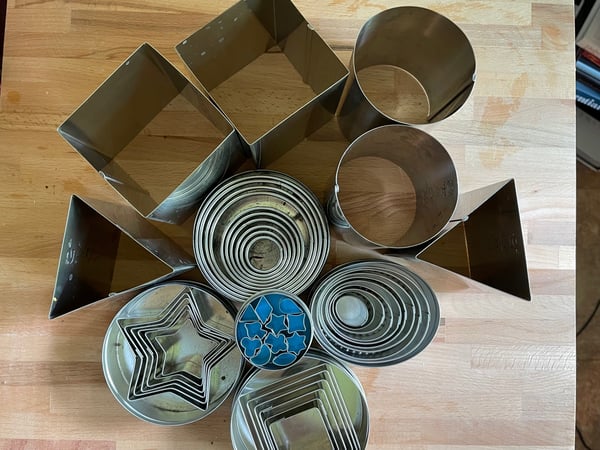 Cookie cutters are also great for creating shapes and most of us have the basic shapes in our stash. You can also just go with the natural shape of the ingredients. Think of a summer Caprese salad. If you find tomatoes the same circumference as your ball of mozzarella, half of your work is done! All I had to do for the one I made below is cut slices.
Cookie cutters are also great for creating shapes and most of us have the basic shapes in our stash. You can also just go with the natural shape of the ingredients. Think of a summer Caprese salad. If you find tomatoes the same circumference as your ball of mozzarella, half of your work is done! All I had to do for the one I made below is cut slices.
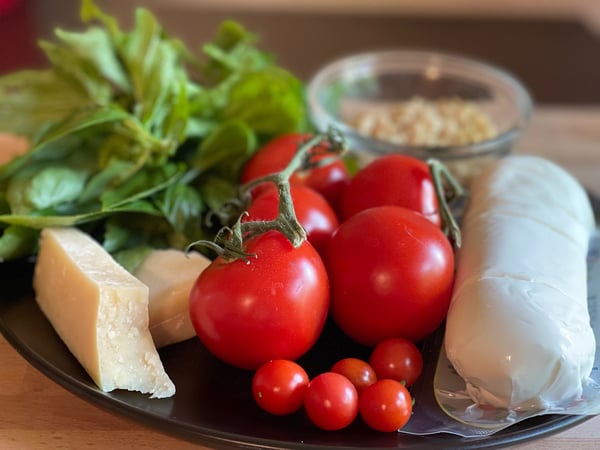
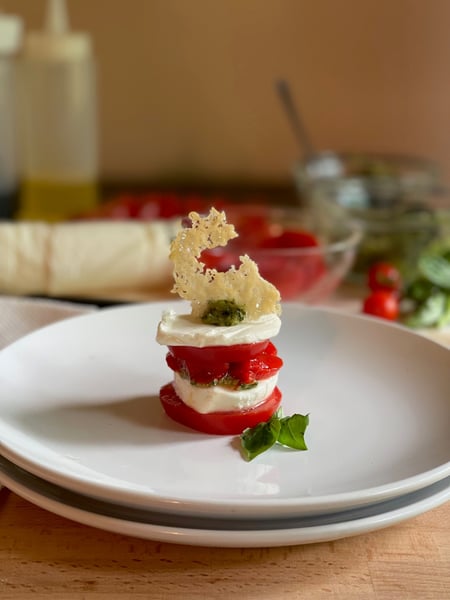 2. Menu: You don’t want an entire meal that is all stacked up, as that would be too much. Look at the courses and pick the one that is constructible and stable. Most of my stacks are cold/room temperature dishes. Hot dishes can be done with bases like rice, polenta or potatoes but there is some finesse in getting it all stacked and to the table hot. This crab cake recipe is one of my go-to’s when we have company.
2. Menu: You don’t want an entire meal that is all stacked up, as that would be too much. Look at the courses and pick the one that is constructible and stable. Most of my stacks are cold/room temperature dishes. Hot dishes can be done with bases like rice, polenta or potatoes but there is some finesse in getting it all stacked and to the table hot. This crab cake recipe is one of my go-to’s when we have company.
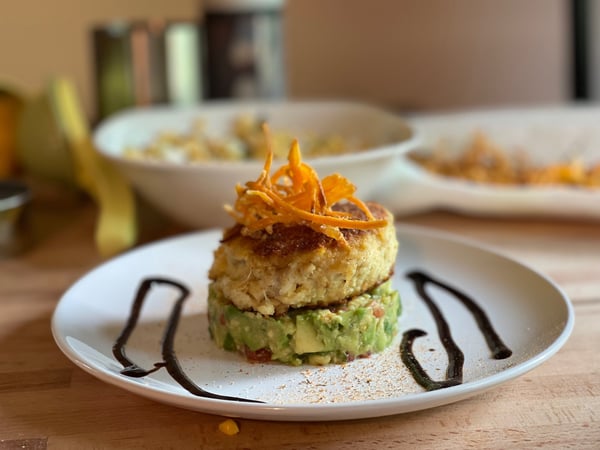 3. Number of Layers: There is no right or wrong number here. I like to go for a good strong base and then maybe 3-6 ingredients on top. You can repeat ingredients or make each layer unique. You want the height but you also want the stability. A leaning tower of pizza will only make a mess. You can create height at the end with a parmesan crisp, a cracker or a cookie. (I used a mold for the avocado base.)
3. Number of Layers: There is no right or wrong number here. I like to go for a good strong base and then maybe 3-6 ingredients on top. You can repeat ingredients or make each layer unique. You want the height but you also want the stability. A leaning tower of pizza will only make a mess. You can create height at the end with a parmesan crisp, a cracker or a cookie. (I used a mold for the avocado base.)
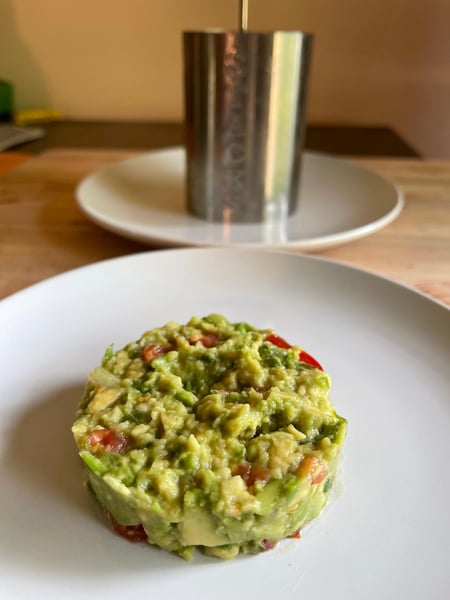 4. Glue: At least one layer needs to be a “glue” for the build. Think about foods like pesto, hummus or whipped cream. The glue offers some stability to the other ingredients. On some dishes, I’ll put a dab on the very bottom to keep the stack from sliding.
4. Glue: At least one layer needs to be a “glue” for the build. Think about foods like pesto, hummus or whipped cream. The glue offers some stability to the other ingredients. On some dishes, I’ll put a dab on the very bottom to keep the stack from sliding.
5. Preparation: This is one of those techniques that you benefit from having all your ingredients lined up and ready to go. If you are daring and going for the warm stacks, warm your plates! It’ll buy you some time. Line up your ingredients in the order you want to stack them. You can even go as far as making a diagram to use as a guide.
During my prep, I take a forkful of all of the ingredients together and take a taste. Do you need to add something or maybe take something away? You want every layer to have a purpose and not get lost in each bite.
6. Plates: When you are plating, make sure you are using a bigger plate. Don’t put a cute crab cake stack on your adorable appetizer plate because when your guest digs in, the stack may topple a little. Nothing takes the fun out of a stack more than if it is falling off your plate and onto your lap! (My dog would disagree.)
7. Garnish: Have some fun. Add a squiggle of balsamic glaze or a sprinkle of herbs. Have that inhibition of a 3-year-old with finger paints. Food should be fun art. If you want to add a squiggle or drizzle, go for it. If it doesn’t look right, don’t do it on all the plates and eat that one really quick. No one will ever know, and you’ll be happy.
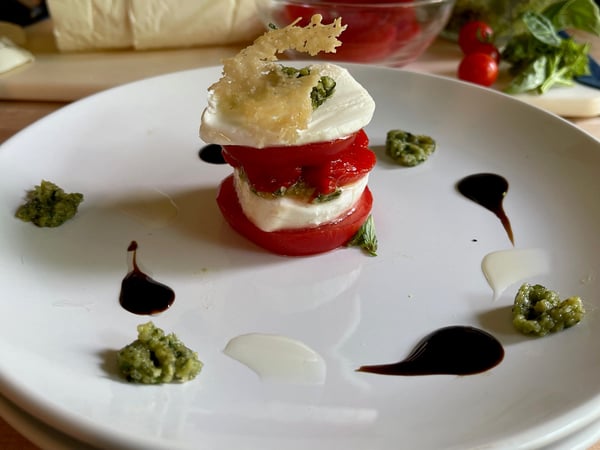 8. Instagroan or Instagram: I highly suggest if you want to take pictures, plate your dish with the setting you want your photo. Sometimes the best planned dish can tip over. It’ll still taste great but you’ll be groaning and not ‘gramming.’
8. Instagroan or Instagram: I highly suggest if you want to take pictures, plate your dish with the setting you want your photo. Sometimes the best planned dish can tip over. It’ll still taste great but you’ll be groaning and not ‘gramming.’
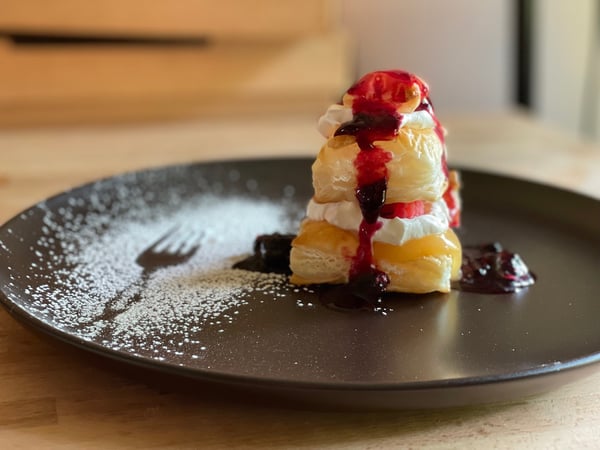 Once you start experimenting, you will come to the conclusion that there are limitless options. Here are some upcoming classes at The Chopping Block that may help add to your stacking skill:
Once you start experimenting, you will come to the conclusion that there are limitless options. Here are some upcoming classes at The Chopping Block that may help add to your stacking skill:
- Virtual Cook Along: Phyllo Workshop is a great start. Phyllo will give you a whole world of shapes to make.
- Virtual Cook Along: Taqueria Workshop. You could make a stack with the tortilla and the tinga!











